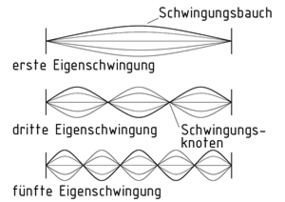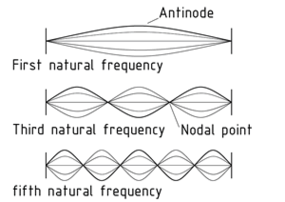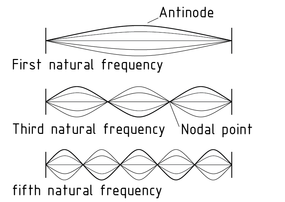
Wählen Sie eine
oder mehrere Sprachen aus
0,1,0
- Deutsch
- Englisch
- Chinesisch
- Spanisch
Eigenschwingung

Eine Eigenschwingung ist die Schwingung eines sich selbst überlassenen schwingungsfähigen Systems (z. B. Schwingkreis, Pendel) nach einer einmaligen Anregung. Meist werden neben einer Grundschwingung bestimmter Frequenz auch Oberschwingungen dieser Eigenschwingung angeregt. Die resultierende Schwingung kann als Überlagerung der angeregten Schwingung dargestellt werden.
Eigenschwingungen entstehen aufgrund von Reflexion in einem begrenzten Wellenmedium. Ihre Frequenz, die Eigenfrequenz, ist dabei von den Eigenschaften des Systems abhängig. Die kleinstmögliche Frequenz ist die Grundfrequenz. Die Schwingungen unterschiedlicher Systeme unterscheiden sich in ihrer Wellenlänge sowie in ihrem Schwingungstyp (Longitudinalschwingung, Transversalschwingung). Aufgrund von Reibungs- und Energieverlusten sind Eigenschwingungen immer gedämpfte Schwingungen.
Die Anzahl der möglichen Eigenfrequenzen stimmt mit der Anzahl der Freiheitsgrade des Systems überein. In schwach gedämpften Systemen entspricht die Eigenfrequenz einer möglichen Resonanzfrequenz.
Mechanische Eigenschwingungen können in Maschinen und Konstruktionen immer ausgelöst werden. Dabei können sie so stark anwachsen, dass Bruch auftritt (etwa Wellenbruch bei Motoren).
Schwingende Systeme werden durch Differenzialgleichungssysteme beschrieben.
Natural oscillation

Natural Oscillation is the oscillation of an oscillatory system (e.g. oscillating circuit, pendulum) when it is left to its own devices after a one-time excitation. In most cases, besides fundamental oscillation in a certain frequency, harmonics of this natural oscillation are also excited. The resultant oscillation can be depicted as a Superposition of the excited oscillation.
Natural oscillations occur due to reflection in a restricted wave medium. Their frequency - the natural frequency - depends on the system's characteristics. The lowest possible frequency is the fundamental frequency. The oscillations of various systems differ in terms of wavelength and type (longitudinal or transverse). Due to Friction and energy losses, natural oscillations are always damped.
The number of possible natural frequencies matches the system's degrees of freedom. In systems with weak damping, the Natural frequency corresponds to a possible Resonance frequency.
Mechanical natural oscillations can always be induced in machinery and structures. They can increase to such a level as to cause ruptures (e.g. a Shaft rupture in motors).
Oscillating systems are described using Differential equation systems.
自然振荡

自然振荡 在对某个振荡系统(例如振荡电路,单摆)进行一次激发后,系统自发进行振荡的现象。在大多数情况下,系统除了按照一定的频率进行基本振荡外,在这种自然振荡情况下,高次谐波也会受到激发。这种情况下,外力会激发出几个振荡,最终结果则是几个振荡的叠加。
由于封闭区间内波的反射的现象,导致系统出现了自然振荡。这时候系统的频率称为 固有频率,而固有频率的大小则取决于系统的特性。系统中可能出现的最低频率又称为基频。不同的系统会出现不同的振荡,其表现形式则是振荡波长和波型不同(纵向或横向)。由于摩擦和能量损失,自然振荡最终会由于阻尼而衰减。
就系统中可能出现的固有频率来说,其数量将与系统的自由度的数量一致。在弱阻尼系统中,该固有频率对应的是可能出现共振的频率。
在机械和建筑结构中,随时都会引发机械自然振荡。而这种振荡还会造成许多不良结果,比如引起破坏(电机轴断裂)。
振荡系统的规律可以利用微分方程式来表达。
自然振荡
近义词
固有频率
基频
Oscilación natural

La oscilación natural es la oscilación de un sistema oscilatorio (por ejemplo, un circuito oscilante, péndulo) cuando se deja por sí sola después de una excitación única. En la mayoría de los casos, además de la oscilación fundamental en una cierta frecuencia, la armonía de esta oscilación natural también es excitada. La oscilación resultante puede ser representada como una superposición de la oscilación excitada.
Las oscilaciones naturales ocurren debido a la reflexión en un medio de onda restringido. Su frecuencia, la frecuencia natural, depende de las características del sistema. La frecuencia más baja posible es la frecuencia fundamental. Las oscilaciones de varios sistemas difieren en términos de longitud de onda y de tipo (longitudinal o transversal). Debido a las pérdidas de energía y fricción, las oscilaciones naturales siempre son amortiguadas.
El número de posibles frecuencias naturales concuerda con los grados de libertad del sistema. En sistemas con amortiguamiento débil, la frecuencia natural corresponde a una posible frecuencia de resonancia.
Las oscilaciones naturales mecánicas siempre pueden ser inducidas en maquinarias y estructuras. Pueden incrementarse a tal nivel que pueden causar rupturas (por ejemplo, ruptura de ejes en motores).
Los sistemas de oscilación se describen mediante sistemas de ecuaciones diferenciales.
Oscilaciones naturales
